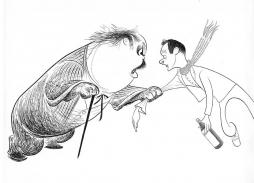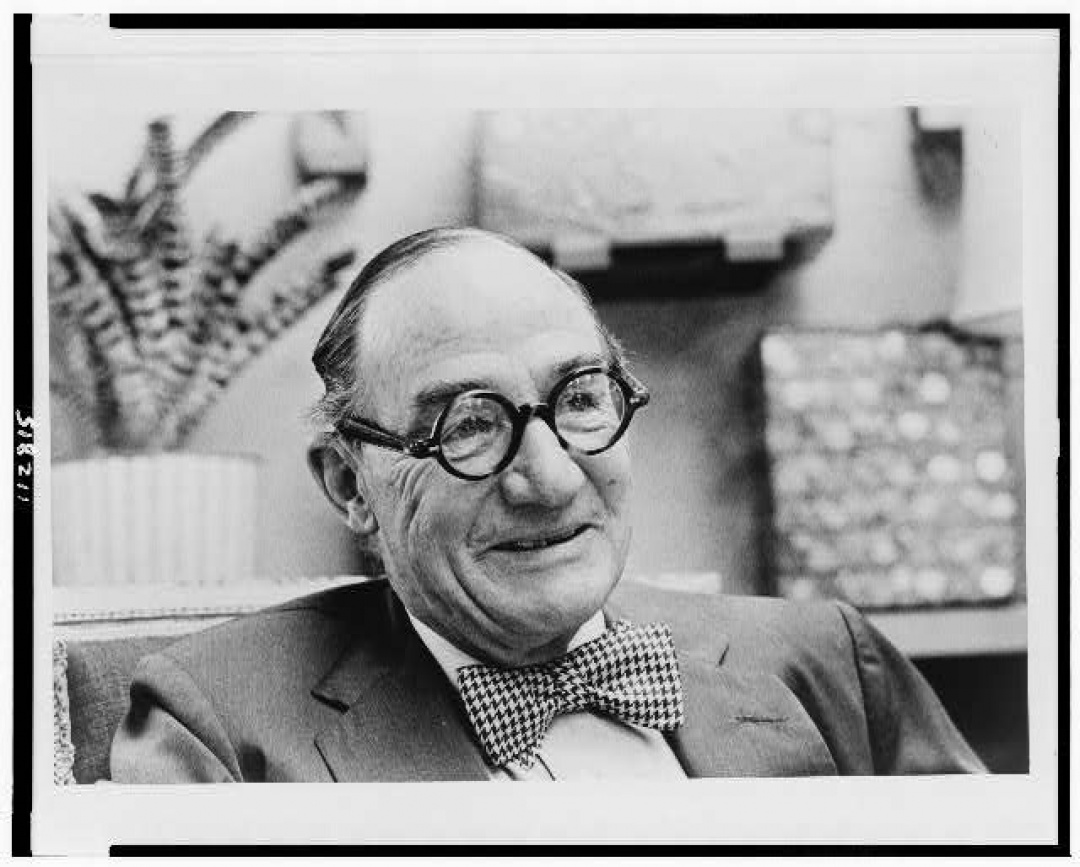When life gets complicated, craftsmanship is a refuge.
Archives for April 2012
TT: So you want to get reviewed
Now that I’m starting to plan my fall travels, it’s time for a newly revised repeat performance of this perennial posting. If you’ve seen it before and aren’t interested, my apologies!
* * *
If you read the Friday Wall Street Journal or this blog with any regularity, you probably know that I’m the only drama critic in America who routinely covers theatrical productions from coast to coast. Don’t take my word for it, though. Ask Howard Sherman, formerly of the American Theatre Wing, who blogged as follows:
To get a regional show to Broadway, one must find a producer who wants to champion the show and take it on as a major commitment. Unfortunately, producers aren’t flying to theatres around the country constantly checking out every possible new play and revival for their next Broadway success. And unless you’re in a major city and you have a preponderance of positive reviews by long established critics (whose numbers are in decline), your own entreaties aren’t likely to cause anyone to jump on a plane unless you already have a relationship with them.
As for “national press” discovering your work and bringing it to the attention of New York bound producers, your only real option is luring The Wall Street Journal‘s Terry Teachout to see your show (and Terry regularly publishes his guidelines for what he’s likely to be interested in). While The New York Times ventures out of town on occasion (though most frequently to the Berkshires, Chicago or London, it seems), it’s rare even for the country’s largest newspaper, USA Today, to see work outside of New York; attention from television and radio is even rarer.
So what if you run a company I haven’t visited? How might you lure me to come see you for the first time? Now’s the time to start asking that question, because I’m hard at work on my reviewing calendar for the first half of the 2012-13 season. Here, then, are the guidelines that I use for deciding which out-of-town shows to see, along with some suggestions for improving the ways in which you reach out to the press:
• Get your schedule to me as soon as possible. That means well in advance of the public announcement. I’ll keep it to myself.
• Basic requirements. I only review professional companies. I don’t review dinner theater, and it’s very unusual for me to visit children’s theaters. (Sorry, but I have to draw the line somewhere.) I’m more likely to review Equity productions, but that’s not a hard-and-fast rule, and I’m strongly interested in small companies.
• You must produce a minimum of three shows each season—and two of them have to be serious. I won’t put you on my drop-dead list for milking the occasional cash cow, but if The Santaland Diaries is your idea of a daring new play, I won’t go out of my way to come calling on you, either.
• I have no geographical prejudices. On the contrary, I love to range far afield, particularly to states that I haven’t yet gotten around to visiting in my capacity as America’s drama critic. Alaska and Colorado continue to loom largest, and I’m also way overdue for a repeat visit to Texas, but if you’re doing something exciting in (say) Hawaii or Mississippi, I’d be more than happy to add you to the list as well.
• Repertory is everything. I won’t visit an out-of-town company that I’ve never seen to review a play by an author of whom I’ve never heard. What I look for on a first visit is an imaginative mix of revivals of major plays—including comedies—and newer works by living playwrights and songwriters whose work I’ve admired. Some names on the latter list: Alan Ayckbourn, Brooke Berman, Nilo Cruz, Brian Friel, Athol Fugard, John Guare, Adam Guettel, A.R. Gurney, Amy Herzog, David Ives, Michael John LaChiusa, Kenneth Lonergan, Lisa Loomer, David Mamet, Martin McDonagh, Conor McPherson, Itamar Moses, Lynn Nottage, Stephen Sondheim, Shelagh Stephenson, and Tom Stoppard.
 I also have a select list of older shows I’d like to review that haven’t been revived in New York lately (or ever). If you’re doing The Beauty Part, The Chalk Garden, The Entertainer, Hotel Paradiso, The Iceman Cometh, Loot, No Time for Comedy, Rhinoceros, The Skin of Our Teeth, The Visit, The Voice of the Turtle, or just about anything by Jean Anouilh, Bertolt Brecht, Rachel Crothers, T.S. Eliot, Horton Foote, William Inge, or Terence Rattigan, kindly drop me a line. (Incidentally, I love door-slamming farces.)
I also have a select list of older shows I’d like to review that haven’t been revived in New York lately (or ever). If you’re doing The Beauty Part, The Chalk Garden, The Entertainer, Hotel Paradiso, The Iceman Cometh, Loot, No Time for Comedy, Rhinoceros, The Skin of Our Teeth, The Visit, The Voice of the Turtle, or just about anything by Jean Anouilh, Bertolt Brecht, Rachel Crothers, T.S. Eliot, Horton Foote, William Inge, or Terence Rattigan, kindly drop me a line. (Incidentally, I love door-slamming farces.)
Finally, I’m very specifically interested in seeing large-cast plays that no longer get performed in New York for budgetary reasons.
• BTDT. I almost never cover regional productions of new or newish plays that I reviewed in New York in the past season or two—especially if I panned them. Hence the chances of my coming to see your production of Clybourne Park are well below zero.
In addition, there are shows that I like but have written about more than once in the past few seasons and thus am not likely to seek out again for the next few seasons. Some cases in point: American Buffalo, Arcadia, Blithe Spirit, A Funny Thing Happened on the Way to the Forum, The Glass Menagerie, God of Carnage, Guys and Dolls, Heartbreak House, Life of Galileo, The Little Foxes, A Moon for the Misbegotten, Mrs. Warren’s Profession, Our Town, Private Lives, She Loves Me, Speed-the-Plow, A Streetcar Named Desire, Twelve Angry Men, Waiting for Godot, West Side Story, and Who’s Afraid of Virginia Woolf? (I am, however, going to keep on reviewing What the Butler Saw until somebody gets it right!)
• I group my shots. It isn’t cost-effective for me to fly halfway across the country to review a single show. Whenever possible, I like to take in two or three different productions during a four- or five-day trip. (Bear in mind, though, that they don’t all have to be in the same city.) If you’re the publicist of the Lower Absentia Repertory Company and you want me to review your revival of The Deep Blue Sea, your best bet is to point out that TheaterAbsentia also happens to be doing Entertaining Mr. Sloane that same weekend. Otherwise, I’ll probably go to Chicago instead.
• I almost never travel in the spring. Broadway is usually so busy in March and April that I’m not able to go anywhere else to see anything else. If you’re going to put on a show that you think might catch my eye, consider doing it between September and February.
• Web sites matter. A lot. A clean-looking home page that conveys a maximum of information with a minimum of clutter tells me that you know what you’re doing, thus increasing the likelihood that I’ll come see you. An unprofessional-looking, illogically organized home page suggests the opposite. (If you can’t spell, hire a proofreader.) This doesn’t mean I won’t consider reviewing you—I know appearances can be deceiving—but bad design is a needless obstacle to your being taken seriously by other online visitors.
If you want to keep traveling critics happy, make very sure that the front page of your Web site contains the following easy-to-find information and features:
(1) The title of your current production, plus its opening and closing dates.
(2) Your address and main telephone number (not the box office!).
(3) A SEASON or NOW PLAYING button that leads directly to a complete list of the rest of the current and/or upcoming season’s productions. Make sure that this listing includes the press opening date of each production!
(4) A CALENDAR or SCHEDULE button that leads to a month-by-month calendar of all your performances, including curtain times.
(5) A CONTACT US button that leads to an updated directory of staff members (including individual e-mail addresses, starting with the address of your press representative).
(6) A DIRECTIONS or VISIT US button that leads to a page containing directions to your theater and a printable map of the area. Like many people, I rely on my GPS unit when driving, so it is essential that this page also include the street address of the theater where you perform. Failure to conspicuously display this address is a hanging offense. (I also suggest that you include a list of recommended restaurants and hotels that are close to the theater.)
This is an example of a good company with an attractive, well-organized Web site on which most of the above information is easy to find.
• Please omit paper. I strongly prefer to receive press releases via e-mail, and I don’t want to receive routine Joe-Blow-is-now-our-assistant-stage-manager announcements via any means whatsoever.
• Write to me here. Mail sent to me at my Wall Street Journal e-mail address invariably gets lost in the flood of random press releases. As a result, I no longer recommend that anyone write to me there. I get a lot of spam at my “About Last Night” mailbox, too, but not nearly as much as I do at the Journal. Any e-mail sent to me at the Journal that contains attachments will be discarded unread.
Really smart publicists will know how to find out my personal e-mail address, and will use it instead of writing to me here.
Finally:
• Mention this posting. I’ve come to see shows solely because publicists who read my blog wrote to tell me that their companies were doing a specific show that they had good reason to think might interest me. Go thou and do likewise.
TT: Just because
Eric Sevareid interviews Eric Hoffer on CBS in 1967:
(This is the latest in a series of arts-related videos that appear in this space each Monday and Wednesday.)
TT: Almanac
“There is no doubt that in exchanging a self-centered for a selfless life we gain enormously in self-esteem. The vanity of the selfless, even those who practice utmost humility, is boundless.”
Eric Hoffer, The True Believer
TT: Recycling bin
In today’s Wall Street Journal I wrap up the current Broadway season with reviews of Nice Work if You Can Get It, Leap of Faith, and Don’t Dress for Dinner. My verdicts are mostly mixed. Here’s an excerpt.
* * *
 Your grandmother is coming to New York for her annual visit. You want to take her to a nice, safe Broadway show, and the two of you saw “Anything Goes” last year. What to do? Simple: Head for “Nice Work if You Can Get It,” a jukebox musical in which Kathleen Marshall endeavors to make lightning strike twice, this time with songs by George and Ira Gershwin instead of Cole Porter. While it’s not nearly as good as its predecessor, it’s also not entirely bad. The songs are classic, the dances are dynamite, and everybody loves Kelli O’Hara. So what if the book is relentlessly unamusing and the acting rigidly derivative? You can’t win ’em all, right?
Your grandmother is coming to New York for her annual visit. You want to take her to a nice, safe Broadway show, and the two of you saw “Anything Goes” last year. What to do? Simple: Head for “Nice Work if You Can Get It,” a jukebox musical in which Kathleen Marshall endeavors to make lightning strike twice, this time with songs by George and Ira Gershwin instead of Cole Porter. While it’s not nearly as good as its predecessor, it’s also not entirely bad. The songs are classic, the dances are dynamite, and everybody loves Kelli O’Hara. So what if the book is relentlessly unamusing and the acting rigidly derivative? You can’t win ’em all, right?
Like “Anything Goes,” “Nice Work” is built inside the husk of an ancient Broadway musical. Joe DiPietro, who wrote the book, has used “Oh, Kay!” as the skeleton for a meta-musical, a brand-new period piece in which the plot of “Arthur” (a rich, likable drunk is forced by his family to propose to the wrong girl, then meets the right one) is transplanted to the Roaring Twenties, tricked out with an assortment of other stock devices and festooned with no less than 21 Gershwin tunes, all but two of which are lifted from other shows. Even the performances are recycled: Ms. O’Hara does Mary Martin, Jennifer Laura Thompson does Madeline Kahn, Michael McGrath does Buddy Hackett, Chris Sullivan does Andy Devine, and Matthew Broderick does Matthew Broderick.
Would that Mr. DiPietro had stolen a few good jokes while he was at it, since “Nice Work” is devoid of them. Fortunately, Ms. O’Hara is her usual sweet self…
 “Leap of Faith,” the musical version of the 1992 film in which Steve Martin played a crooked evangelist who has a crisis of faithlessness, is as slick as ice on Teflon. To be sure, Raúl Esparza, the hard-working star, is smooth in the wrong way–he comes across like a talk-show host, not a sequin-spangled faith healer–and none of the other members of the immensely likable cast give the impression of having traveled much farther west than Chelsea. But if you’re looking for pure Broadway razzmatazz, “Leap of Faith” delivers the goods. Robin Wagner’s set turns the interior of the St. James Theatre into a revival tent, and Christopher Ashley and Sergio Trujillo, the director and choreographer, put every square inch of it to effective use. The chorus rocks and rolls. The gospel-style songs, by Alan Menken and Glenn Slater, are rousingly lively (though the ballads, as usual with Mr. Menken, sound like ’70s sitcom themes).
“Leap of Faith,” the musical version of the 1992 film in which Steve Martin played a crooked evangelist who has a crisis of faithlessness, is as slick as ice on Teflon. To be sure, Raúl Esparza, the hard-working star, is smooth in the wrong way–he comes across like a talk-show host, not a sequin-spangled faith healer–and none of the other members of the immensely likable cast give the impression of having traveled much farther west than Chelsea. But if you’re looking for pure Broadway razzmatazz, “Leap of Faith” delivers the goods. Robin Wagner’s set turns the interior of the St. James Theatre into a revival tent, and Christopher Ashley and Sergio Trujillo, the director and choreographer, put every square inch of it to effective use. The chorus rocks and rolls. The gospel-style songs, by Alan Menken and Glenn Slater, are rousingly lively (though the ballads, as usual with Mr. Menken, sound like ’70s sitcom themes).
What “Leap of Faith” lacks are sweat and heart, the absence of which will only be bothersome if you permit yourself to imagine how this well-oiled applause machine might have run had its creators taken the plot seriously….
Were I ever to teach a course in how to stage farce, I’d show a video of the Roundabout Theatre Company’s production of “Don’t Dress for Dinner” so that my students would know what not to do. Written by Marc Camoletti, the author of “Boeing-Boeing,” the seven-door farce mounted to diverting effect by the Roundabout four years ago, “Don’t Dress for Dinner” is a comparably complicated comedy about a pair of married philanderers (Adam James and Patricia Kalember), the people with whom they cheat (Jennifer Tilly and Ben Daniels), and a French cook of the utmost avariciousness (Spencer Kayden, who was so good in “Urinetown”). When done well, it’s a hoot, but John Tillinger, the director, has made the amateurish mistake of encouraging his actors to troll aggressively for laughs instead of letting the situation generate them….
* * *
Read the whole thing here.
TT: Repeat after me
The Broadway season ended yesterday, and the indefatigable Mrs. T and I will soon be on our way to Chicago, where we plan to see four shows (five if you count the two parts of Angels in America separately) at the Court Theatre, Next Theatre Company, the Goodman Theatre, and Chicago Shakespeare. In between we’ll be hanging out with Our Girl in Chicago, whom we haven’t seen for months and months.
I’ll try to keep you posted, but it’s going to be a hectic week, so be patient, O.K.? More as it happens, or shortly thereafter….
TT: Who was Joseph Alsop?
Yesterday I reviewed The Columnist, David Auburn’s new play about Joseph Alsop. In today’s Wall Street Journal “Sightings” column, I fill in some of the blanks about Alsop, who is no longer well known. Here’s an excerpt.
* * *
Nobody remembers Joseph Alsop now, but in his day he was as famous as a journalist could be. A white-shoe-leather political columnist who went from Groton to Harvard to the New York Herald Tribune in three easy steps, he spent the whole of his life rubbing elbows with powerful pols whom he flattered assiduously, then wrote about in his widely read newspaper column. He was also a closeted homosexual who mistakenly supposed that no one knew of his after-hours inclinations. In fact, Alsop’s friends were well aware that he was gay–and so were his enemies.
 David Auburn’s “The Columnist,” which opened on Broadway this week, hinges on something that happened to Alsop when he visited Moscow in 1957, at the height of the Cold War. It seems that he picked up a young man at a party and spent the night with him, not knowing that the fellow in question was a KGB operative and that he had inadvertently stumbled into what is known to intelligence agents as a “honey trap.” Alsop and his companion were secretly photographed having sex, and the next day the columnist was informed that if he didn’t agree to serve as an “agent of influence” for the Soviet Union after returning to America, he would be exposed as a homosexual, thrown in jail and left to rot….
David Auburn’s “The Columnist,” which opened on Broadway this week, hinges on something that happened to Alsop when he visited Moscow in 1957, at the height of the Cold War. It seems that he picked up a young man at a party and spent the night with him, not knowing that the fellow in question was a KGB operative and that he had inadvertently stumbled into what is known to intelligence agents as a “honey trap.” Alsop and his companion were secretly photographed having sex, and the next day the columnist was informed that if he didn’t agree to serve as an “agent of influence” for the Soviet Union after returning to America, he would be exposed as a homosexual, thrown in jail and left to rot….
That is, needless to say, quite a tale, and it’s easy to see why Mr. Auburn thought that it would make a rattling good play. But unless you know the history of American political journalism, certain parts of “The Columnist” may be a bit confusing, especially since it’s likely to leave uninformed viewers with the impression that Alsop, who was a staunch supporter of U.S. involvement in the Vietnam War, was a conservative. He was, in fact, a liberal anti-Communist, an FDR-loving New Deal Democrat who was violently opposed to both Joe McCarthy and the Soviet Union….
In addition, I suspect that many of those who see Mr. Auburn’s play will find it understandably hard to believe that a mere newspaper columnist could possibly have wielded the power that Alsop is portrayed as having in “The Columnist.” Today’s columnists derive such influence as they may have not from their writing but from their television appearances, which are the real source of their fame. A columnist who isn’t seen regularly on TV might as well be talking to himself. But in Joe Alsop’s day, it was perfectly possible for an op-ed columnist to win fame solely on the strength of what he wrote….
* * *
Read the whole thing here.
TT: Almanac
“A dying man needs to die, as a sleepy man needs to sleep, and there comes a time when it is wrong, as well as useless, to resist.”
Stewart Alsop, Stay of Execution
